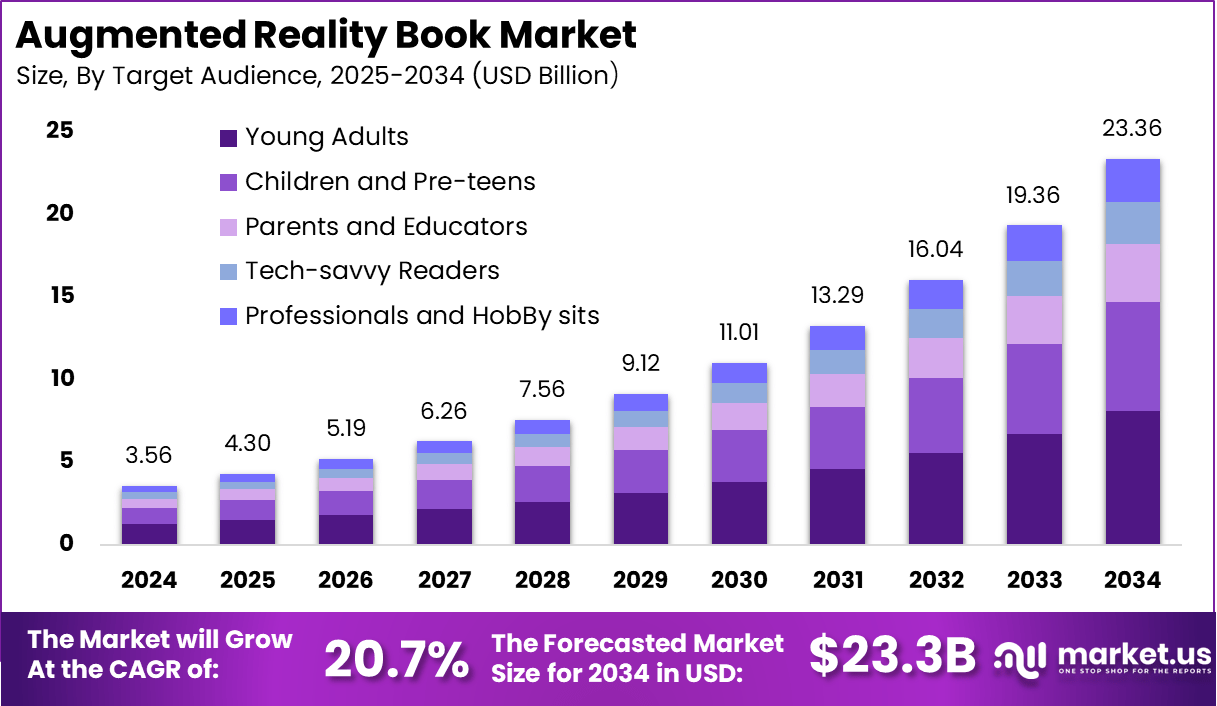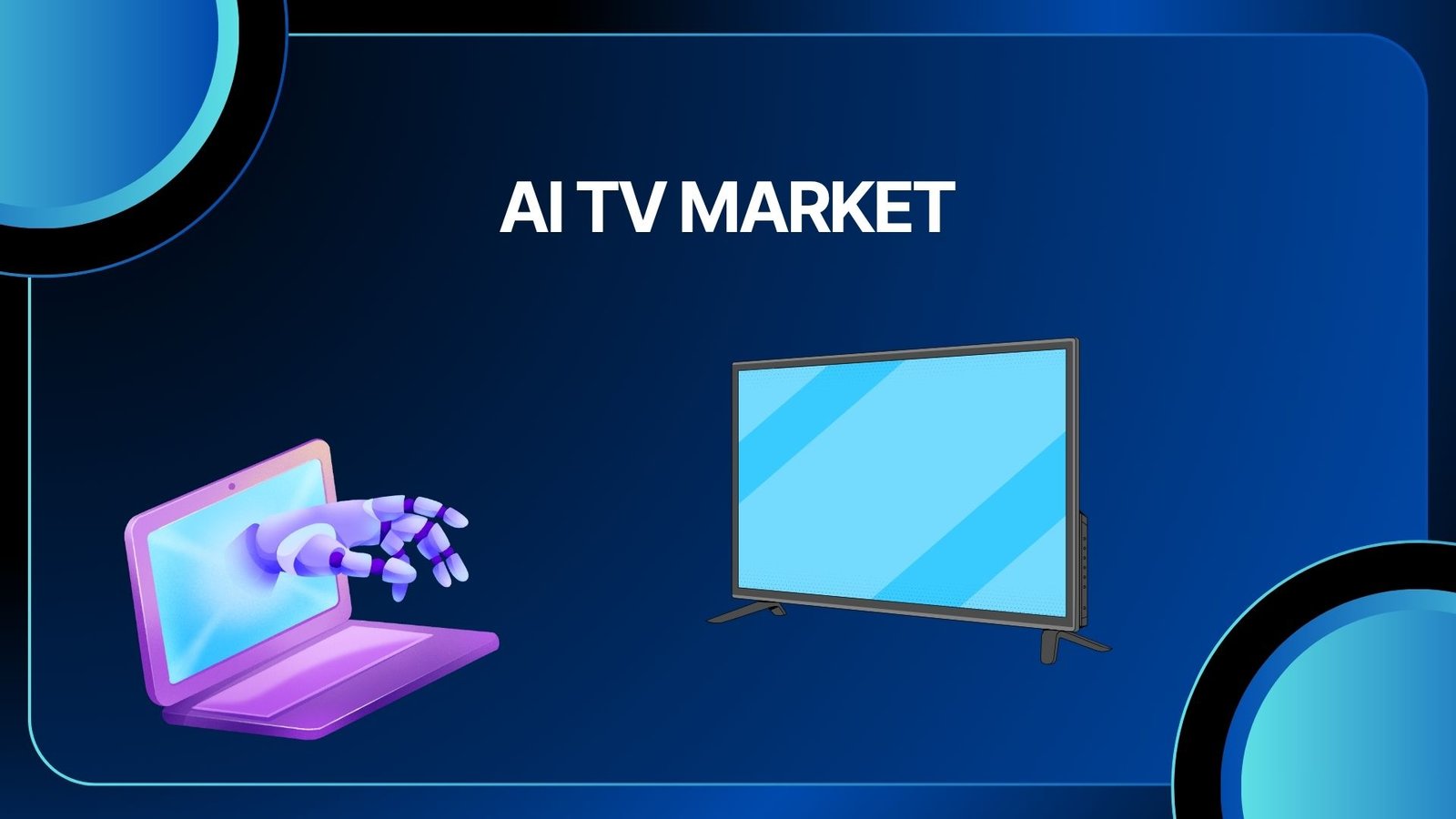Augmented Reality Book Market to Reach USD 23.36 Billion By 2034
Updated · Sep 10, 2025

WHAT WE HAVE ON THIS PAGE
Introduction
In 2024, the Global Augmented Reality Book Market was valued at USD 3.56 billion and is forecasted to expand significantly, reaching nearly USD 23.36 billion by 2034. This growth reflects a strong CAGR of 20.7% between 2025 and 2034, driven by the rising integration of interactive AR content in education, publishing, and entertainment. Increasing consumer demand for immersive learning experiences and the adoption of AR platforms in classrooms are expected to play a central role in accelerating adoption.
The Augmented Reality (AR) Book Market refers to the industry segment focused on printed or digital books enhanced by AR technology. These books combine traditional reading with interactive visual elements that are accessed through mobile devices, tablets, or AR headsets. AR features include 3D animations, audio narratives, virtual characters, and real-time visual overlays that appear when the book is scanned using a compatible device. AR books are used in education, children’s storytelling, language learning, science demonstrations, and entertainment publishing.
In the education sector, AR books help improve student engagement and knowledge retention. Publishers are using AR features to attract younger readers and adapt to changing reading habits. The growing availability of affordable smartphones and tablets has made AR technology more accessible, encouraging publishers to experiment with immersive formats. Demand from parents and educators for creative learning tools is also contributing to market expansion.

According to data from Exploding Topics, augmented reality is moving rapidly toward mainstream adoption. Global revenue is projected to surpass USD 50 billion by 2027, showing its strong commercial momentum. At the same time, the user base is already large, with about 1.4 billion active devices supporting AR experiences, underscoring how widely the technology has penetrated everyday life.
Awareness levels are also notable. Nearly three in four adults under the age of 44 are familiar with augmented reality, which highlights its generational appeal. Younger demographics, in particular, are driving adoption through use in gaming, social media, and learning applications. This combination of high awareness, a vast device base, and strong revenue growth confirms AR’s trajectory as a transformative digital technology with expanding opportunities in both consumer and enterprise markets.
Key Insight Summary
- Educational AR Books led the content type segment, holding 25.87% share.
- Young Adults were the main target audience, representing 34.6% share.
- Print + AR Integration dominated the format category with 38.7% share.
- Fantasy and Science Fiction emerged as the leading genre, securing 35.9% share.
- North America held the top regional position with 40.2% share.
- The U.S. market was valued at USD 1.21 Billion, growing at a strong 16.8% CAGR.
Analysts’ Viewpoint
From a demand perspective, the AR book market is growing rapidly due to increased adoption in schools, universities, libraries, and entertainment sectors. Remote and hybrid learning models have accelerated the need for digital tools that replicate in-person engagement, positioning AR books as valuable resources. The entertainment industry also benefits from AR books by offering immersive stories and games that appeal to consumers seeking richer, sensory experiences beyond traditional print. This expanding use across both education and entertainment sectors is driving consistent market growth and broadening consumer interest.
Increasing adoption of AR technologies in the book market depends heavily on advancements in 3D modeling, image recognition, and cloud-based content delivery. Development of user-friendly AR authoring tools enables publishers and creators to produce high-quality content with greater ease. The falling cost of AR hardware and the rising availability of smartphones and tablets equipped with AR capabilities further stimulate adoption. These technologies help create seamless, engaging, and interactive experiences that increase reader satisfaction and encourage repeat usage.
Key reasons for adopting AR books include their ability to enhance user engagement and comprehension by supplementing static text with multimedia content that stimulates multiple senses. This approach supports better retention of information, particularly in educational contexts. Publishers and content creators also benefit because AR books offer new revenue streams through interactive and differentiated products. For educators, AR books facilitate more inclusive and effective learning methods, catering to different learning styles and increasing student motivation.
Regional Analysis
North America held a dominant market position in 2024, accounting for more than 40.2% of global share with revenues of USD 1.4 billion. The region’s leadership is supported by advanced digital infrastructure, widespread use of AR-enabled devices, and strong investments in educational technology. Moreover, collaborations between publishers, edtech firms, and AR developers are strengthening the ecosystem, making North America the primary hub for innovation and commercialization of AR-based reading solutions.

Driver Analysis
Growing Demand for Immersive Reading Experiences
One key driver of the augmented reality (AR) book market is the rising demand for interactive and immersive reading experiences. Modern readers, especially younger ones, expect more engaging content that goes beyond traditional print. AR technology allows books to come alive with multimedia features like videos, 3D animations, and interactive graphics accessible via smartphones or tablets. This creates a multisensory experience that keeps readers engaged and enhances their understanding and retention of the content.
The widespread use of AR-capable devices has expanded the audience for these enhanced books, making them more popular in both education and entertainment sectors. The rise of smartphones and tablets equipped with AR technology has made access to AR books easier and more convenient. This accessibility supports growth by attracting a broader user base that favors personalized, participatory content.
Publishers are increasingly integrating AR features to create distinctive books that offer a richer experience than conventional reading. Schools and educational institutions particularly benefit from AR books as they help simplify complex topics through visual storytelling and interactive simulations, fostering active learning.
Restraint Analysis
High Development Costs
A significant restraint in the AR book market is the high cost of developing AR content. Creating AR books requires specialized skills in 3D modeling, animation, and software development, which drives up production expenses beyond those associated with traditional publishing. Collaboration between authors, illustrators, and AR technology developers adds complexity and cost. This financial barrier is especially challenging for smaller publishers and independent authors who might lack the necessary capital or expertise to invest in this technology.
Furthermore, AR technology evolves rapidly, requiring ongoing updates and maintenance to ensure compatibility with the latest devices and platforms. Such continuous investment in content and technology adaptation can deter some publishers who worry about uncertain returns on investments. The sizeable upfront development expenditure makes many companies cautious, slowing the broader adoption of AR books in certain segments of the market.
Opportunity Analysis
Transformation of Education Sector
The education sector presents a major opportunity for AR books to transform how students engage with learning materials. AR can enhance textbooks by adding interactive 3D models, virtual experiments, and real-world simulations that help students grasp complex subjects more effectively. This form of experiential learning improves engagement and knowledge retention, addressing limitations of traditional printed books.
Remote and hybrid learning models, which have become more common after the COVID-19 pandemic, further boost demand for AR educational tools. AR books are ideal for these environments, enabling interactive content delivery that supports various learning styles. The ability to make education more accessible and engaging positions the AR book market to grow significantly as digital learning adoption rises globally.
Challenge Analysis
Infrastructure and Device Accessibility
One of the primary challenges facing the AR book market is the dependence on specific hardware and infrastructure. AR books often require smartphones, tablets, or AR headsets with sufficient processing power and camera technology. Access to such devices is limited in certain regions, especially where disposable incomes are low or digital infrastructure is underdeveloped. This restricts the reach of AR books in emerging and less-developed markets.
Additionally, the cost of AR-enabled devices remains relatively high for many users, creating a barrier to widespread adoption. Technical issues such as software compatibility and frequent need for updates can disrupt user experience and discourage continued use. These challenges mean that despite strong potential, the AR book market must overcome device accessibility and infrastructure limitations to achieve broader global penetration.
Key Market Segments
By Content Type
- Educational AR Books
- Children’s AR Books,
- Fiction and Non-Fiction AR Books
- Travel AR Books
- Interactive Cookbooks
- Others
By Target Audience
- Young Adults
- Children and Pre-teens
- Parents and Educators
- Tech-savvy Readers
- Professionals and HobBy sits
By Format
- Print + AR Integration
- Digital-Only AR Books
- Audio-Visual AR Books
- Augmented Audio Books
- Subscription-Based AR Content
By Genre
- Fantasy and Science Fiction
- Mystery and Thriller
- Self-Help and Personal Development
- Textbooks and Reference Materials
- Graphic Novels and Comics
Top Key Players in the Market
- Holokitab
- NexGen Innovators IT Services Pvt Ltd
- Ludenso
- Artivive GmbH
- cxocARd
- Vijua
- Blippar Group Limited
- DEVAR Entertainment LLC
- Lightning Source LLC
- Poplar Studio
- Others
Read More – https://market.us/report/global-augmented-reality-book-market/
Sources

After graduating in Electrical Engineering, Maitrayee moved into writing after working in various technical roles. She specializes in technology and Artificial Intelligence and has worked as an Academic Research Analyst and Freelance Writer, focusing on education and healthcare in Australia. Writing and painting have been her passions since childhood, which led her to become a full-time writer. Maitrayee also runs a cooking YouTube channel.










